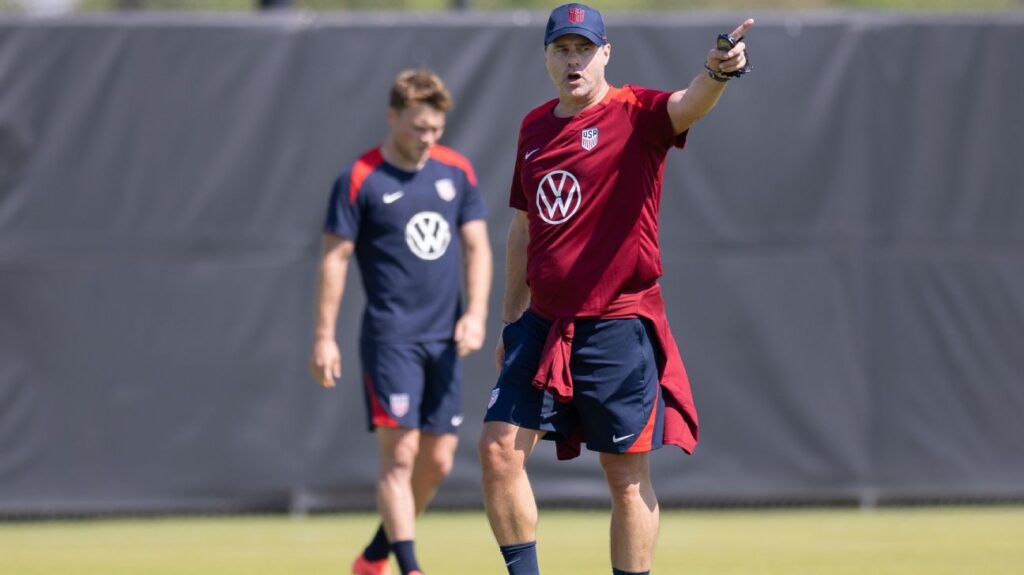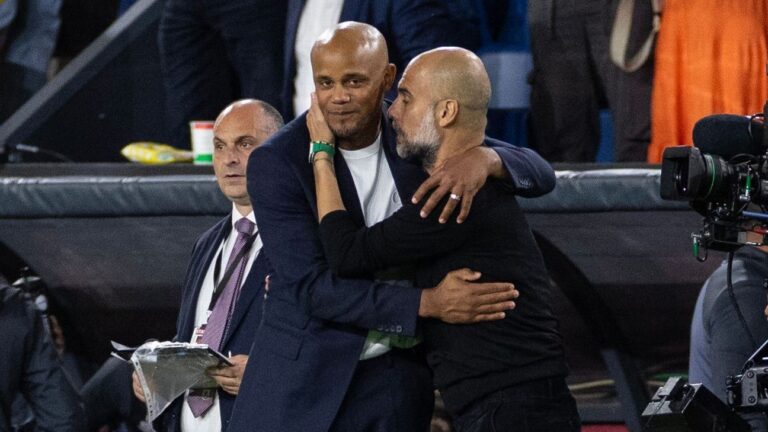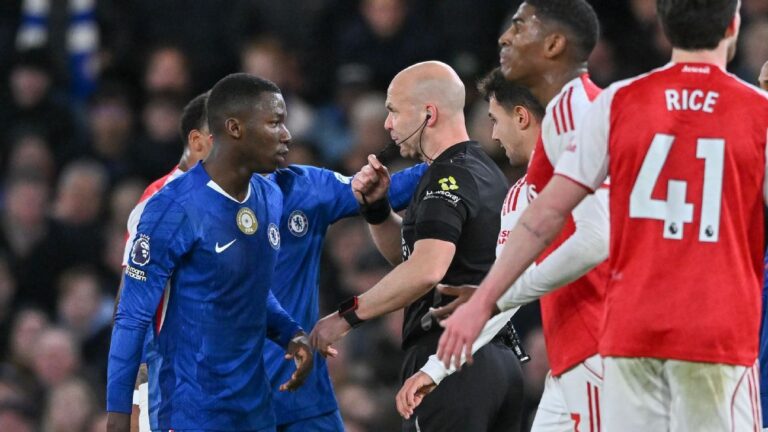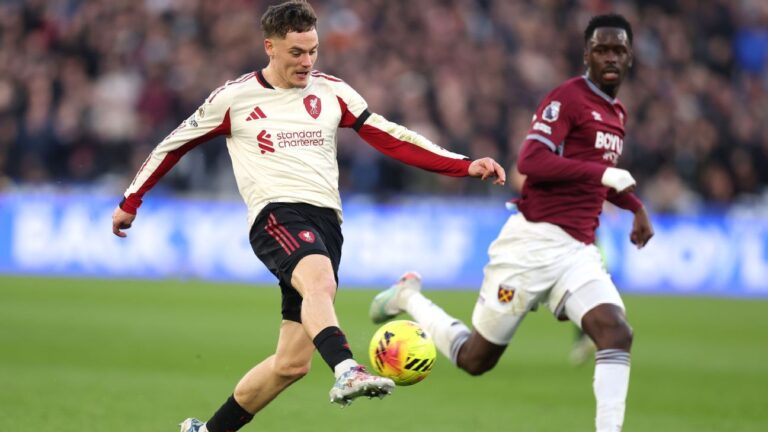Earlier this week, the players on the U.S. men’s national team took the first steps into a new frontier as they experienced their first training sessions under new head coach Mauricio Pochettino. He provided a taste of what to expect at his introduction last month.
“The player needs to feel that you care,” Pochettino said at his September news conference in New York. “When the player feels that you care, you can get the best of them. We are going to work and to create the right pattern to follow, to get the confidence, to recover the confidence and start to perform together.”
Every player is starting fresh from a blank canvas, so what are they going to get from their new boss? To sum it up in a word: intensity.
“Yeah, straight away it seems a little bit more intense,” left-back Antonee Robinson said at a news conference on Tuesday. “[Pochettino] knows that we’ve got a short period of time to kind of understand the principles he wants us to play with and tactics and whatnot. … So, yes, obviously small steps, but it definitely feels like camp’s going to be a period where we’ll have time to enjoy it, but we’re going to work hard and really build towards success.”
Stylistically, there is a tendency to lump in Pochettino with his primary coaching mentor, Marcelo Bielsa. The two first crossed paths at Argentine side Newell’s Old Boys, where Pochettino made his professional debut as a 17-year-old. They continued to bump into each other throughout Pochettino’s career, later for a brief spell at Espanyol and then with the Argentina national team.
Looking at Pochettino’s career, though, the characterization of being Bielsa 2.0 doesn’t quite fit. In fact, it could be argued there are two Pochettinos: a very dogmatic one at first — at Espanyol, Southampton and Tottenham Hotspur — and a more pragmatic one who has emerged since he left Spurs in November 2019 and took jobs with Paris Saint-Germain and then Chelsea.
Dogmatic Pochettino was very much influenced and inspired by Bielsa, who preached the importance of relentless pressing, winning back possession and quick-strike transitional play. Pochettino’s obsession was to press high via one-on-one marking with full-backs playing high up the field. To play with such intensity, his teams needed to be beyond peak fitness.
During his spells with Saints and Spurs, it wasn’t unusual for his players to have three training sessions a day during preseason. His teams regularly were in the top three in the Premier League in terms of distance covered per game.
At Southampton, players still remember that at the start of every Monday training session — just 24 or 48 hours after playing 90 minutes in a Premier League game — the manager always asked them to run 12 laps around a full pitch. They didn’t understand the logic of it. When Rickie Lambert decided to have a word with Pochettino on behalf of the squad, the coach replied: “OK, I understand.” The following Monday, and every Monday that followed that season, he made them run 24 laps.
“He doesn’t like when you dispute his authority,” one former Southampton player told ESPN. “He felt that running that much on a Monday was for the good of the team, so he was never going to change. Actually the opposite.”
Despite some complaints, there was no arguing with the results. The team exceeded expectations: After finishing 14th in the 2012-13 Premier League season on 41 points and a minus-11 goal differential, Pochettino’s Saints finished eighth in the 2013-14 season on 56 points and a plus-8 goal differential.
It was the same in north London after he moved to Tottenham. With young, hungry players such as Harry Kane and Dele Alli at his disposal, Pochettino could demand the same intensity that he did on England’s south coast, but of a squad that possessed more talent. Together, they finished second in the Premier League in the 2016-17 season, the club’s highest finish since 1963, and reached the Champions League final in 2019, the best continental campaign in club history.
That ability to push players will be critical on a U.S. team that looked too comfortable and set in its ways as it flamed out of the Copa América group stage last summer. Tyler Adams, in an interview with “Men in Blazers,” said at one point during the U.S. managerial search that the USMNT needed someone who was “ruthless” and would tell the players what needed to be done. The players appear to be getting that, as well as a coach keen on developing relationships with them.
“The only people that won’t fully get on board with [Pochettino] are people that don’t work hard,” said former U.S. international Brad Friedel, who was part of the Spurs squad during Pochettino’s first season in north London in 2014-15. “I don’t mean you have to, like, run around like a crazy man. … Just approach your [job] in a professional manner.”
Friedel added that reputations and what has happened in the past count for little with Pochettino. If a player performs well, and is a good pro, then they’ll play. If they don’t, they’ll find themselves on the bench.
“It really is pretty simple stuff,” Friedel said. “There’s nothing complicated about playing for Mauricio. He’s a really fun guy to play your football for.”
That sentiment was shared throughout much of the Spurs dressing room. Many of those players shed tears when he was dismissed by the club after five-plus seasons in charge.
“He was a game changer. He was very demanding, but in the right way,” former Tottenham goalkeeper and current LAFC No. 1 Hugo Lloris told ESPN. “He wanted us to play with intensity. We used to train so hard so then games would feel easier. We would press so much, recovering the ball so high to attack straight away.”
For others, he could be more difficult. No manager is going to be able to reach every player, and that’s especially true for those who are struggling to get on the field.
“He would not tell you why you were not picked or why you were not playing,” one former Spurs player said to ESPN. “If you wanted a chat with him, you had to go and see him, and even then you could tell, he didn’t appreciate it.
“He would often refer to God making things happen or not for players and games. It was very frustrating because he was clearly a great coach but had this weird arrogance about himself when it came to relationships with some of the players.”
Pragmatic Pochettino has evolved from his dogmatic ways, although one could argue he had no choice when he took charge of PSG in January 2021. Instead of molding another young, hungry and impressionable squad in his image, he inherited a difficult dressing room full of big egos, including Kylian Mbappé, Neymar and Lionel Messi.
Forget about the super intensity and high press. There were no triple training sessions in Paris and there wasn’t much tactical work, either. Pochettino tried to let the players express themselves, but he proved to be a less-than-ideal fit. He experimented with formation and personnel, building around a front three of Messi, Neymar and Mbappé, but he never really felt he could do what he wanted with the team.
Pochettino was dismissed from the French capital club in July 2022. He won Ligue 1 in his only full season in charge, but his final match in the Parc des Princes dugout was marred by a fan walkout following PSG’s Champions League round-of-16 capitulation to Real Madrid.
The lack of tactical work is a criticism that resurfaced during his time at Chelsea, too. Moisés Caicedo publicly said training was pretty much all about running and largely bereft of tactical work. Other players in the Blues squad told ESPN the same thing. Pochettino relied on the physical ability of his players at Stamford Bridge.
That said, Caicedo later credited Pochettino with helping him get his game back on track after the Ecuador international struggled to live up to the expectations that came with his British-record £115 million transfer from Brighton & Hove Albion. As the players became more familiar with Pochettino’s approach, the team blossomed. Chelsea finished the 2023-24 season sixth in the table and played at a top-four points-per-game pace after the turn of the year.
All of this points to Pochettino’s approach becoming more flexible. He said after last week’s roster announcement that he’ll primarily use two formations: 4-3-3 as well as its close cousin, 4-2-3-1. That aligns with what he used earlier in his career, although his approach often morphed into a very attacking 3-5-2 with a lot of runs in behind from the forwards and width provided by his full-backs.
One of his stylistic pillars, in addition to pressing high, is playing out of the back. Recent evidence suggests there is reason to question whether the USMNT have the players to employ that style, especially against high-pressing teams. As he has demonstrated, though, Pochettino is plenty capable of adapting.
“Pochettino likes to play out of the back, but if he needs to be pragmatic, he will,” said Friedel, who is now the sporting director at Turkish Super Lig side Besiktas. “If he doesn’t think that his goalkeeper and center-backs can play out of the back, he won’t. He’s smart. He’ll see what he has.”
He will indeed. The players will, too. The hope is that it’s the start of a beautiful relationship.




